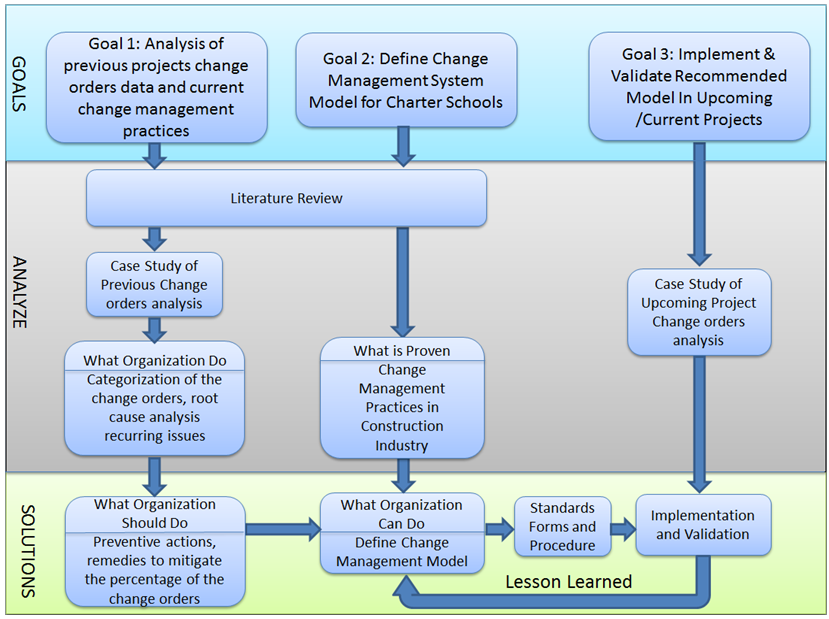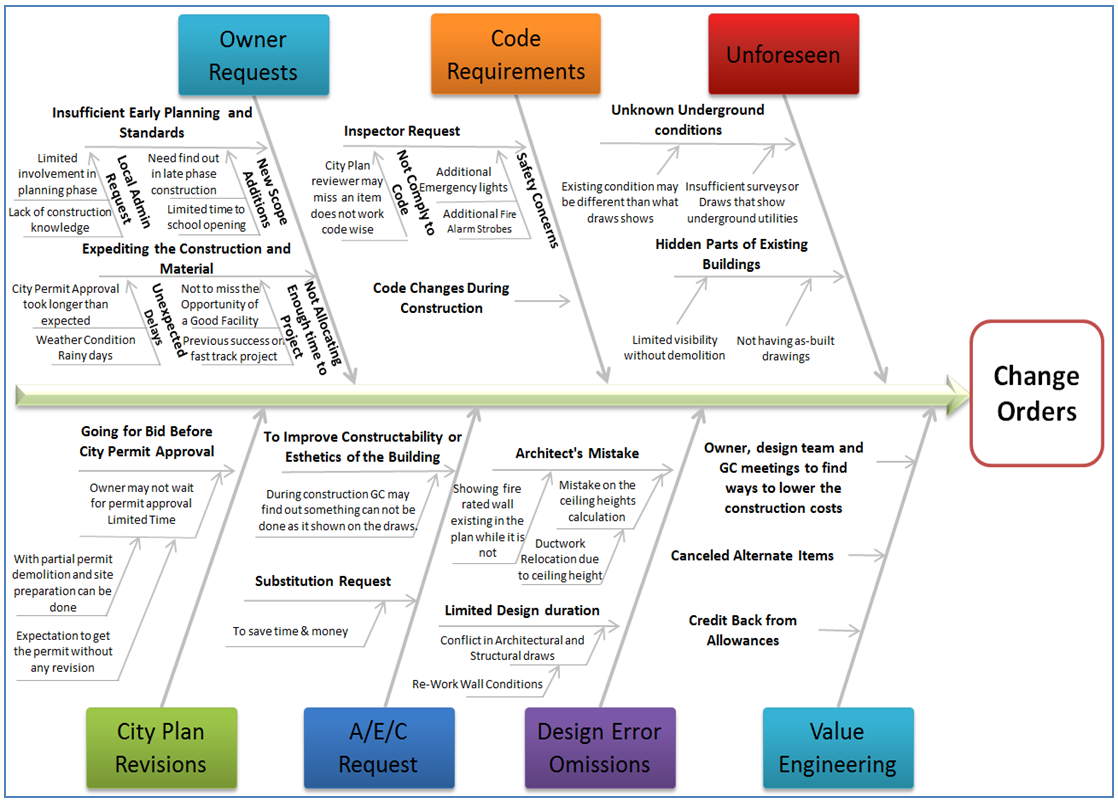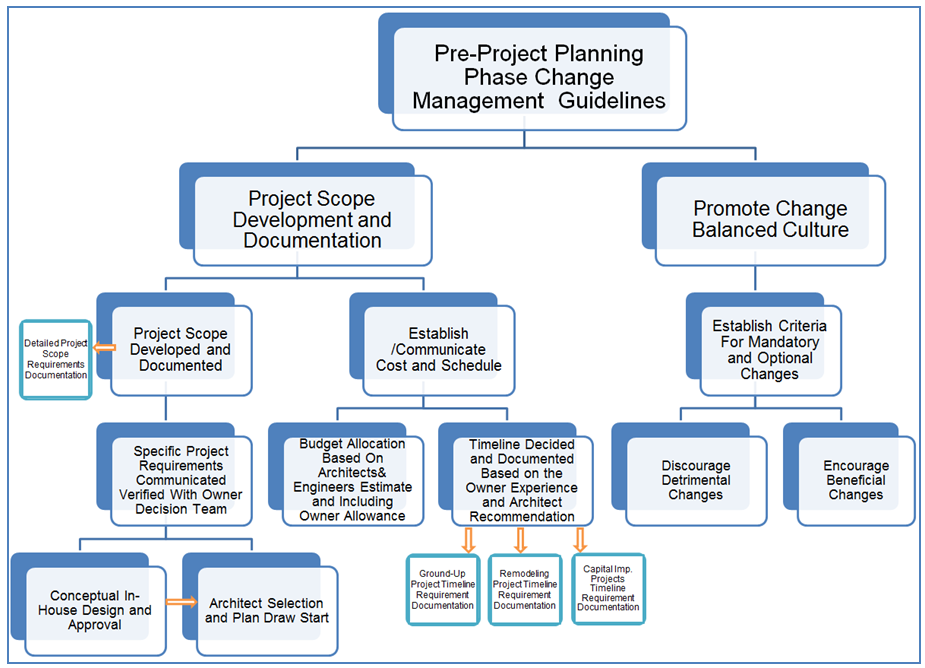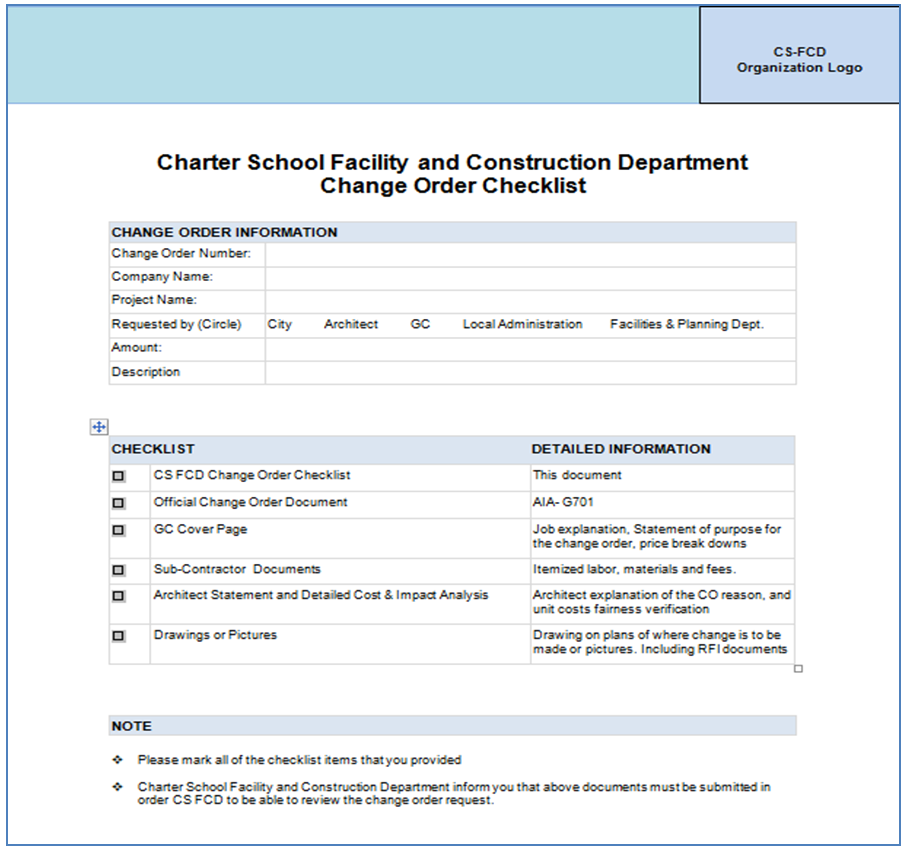-
Paper Information
- Paper Submission
-
Journal Information
- About This Journal
- Editorial Board
- Current Issue
- Archive
- Author Guidelines
- Contact Us
International Journal of Construction Engineering and Management
p-ISSN: 2326-1080 e-ISSN: 2326-1102
2019; 8(2): 56-69
doi:10.5923/j.ijcem.20190802.03

Change Order Management System for Charter School Construction Projects
Ahmed Senouci, Hasan Unal, Neil Eldin
Department of Construction Management, University of Houston, Houston, USA
Correspondence to: Ahmed Senouci, Department of Construction Management, University of Houston, Houston, USA.
| Email: |  |
Copyright © 2019 The Author(s). Published by Scientific & Academic Publishing.
This work is licensed under the Creative Commons Attribution International License (CC BY).
http://creativecommons.org/licenses/by/4.0/

This study develops a change order management system to decrease change management issues for charter school construction. A literature review of change orders causes, categorization, and change management practices were first conducted. A large set of change order data was compiled from several Texas Charter schools including five ground-ups, seventeen remodels and six capital improvements. A root cause analysis and a correlation analysis was conducted to better understand the recurring issues and the project correlated parameters that increase change order percentages and cause delays. The analysis of previous project change order data and best management practices were used to control, manage, and reduce change order percentages. Because of time limitation, 90% of the proposed change management practices were applied to one ground-up and three remodeling projects that were completed in August 2016. With the help of the proposed change management practices, all of these projects were successfully completed on time. Moreover, 21% and 24% reductions in change order percentages were achieved for ground-up and remodeling projects, respectively.
Keywords: Change order management, Charter schools, Case study data, School construction
Cite this paper: Ahmed Senouci, Hasan Unal, Neil Eldin, Change Order Management System for Charter School Construction Projects, International Journal of Construction Engineering and Management , Vol. 8 No. 2, 2019, pp. 56-69. doi: 10.5923/j.ijcem.20190802.03.
Article Outline
1. Introduction
- The Texas Charter School Association defines public charter schools as tuition-free, open enrollment public schools that have the flexibility to adapt to the educational needs of individual students. These schools are also held to strict state academic and financial accountability standards (Texas Character Schools Association 2013). The National Alliance for Public Charter Schools, the enrollment in public charter schools has increased six times during a period of 15 years (National Alliance for Public Charter Schools 2016). The high demand for charter schools in the U.S has increased the need to construct new facilities and renovate existing ones. One of the largest Texas charter schools has completed 6 ground-up, 20 remodeling & expansion, and 6 capital improvement projects in the last four years to accommodate the high demand for charter schools. It is inevitable that construction projects experience change orders that cause delays and cost overruns. A change order is a “formal directive change to a construction contract that typically includes a modification in work scope, an adjusted contract price, and any changes to the time to perform the work” (O’Brien, 1998). According to the Construction Industry Institute(CII), change orders may interrupt work flow, create delays, cause schedules to slip, inflate costs, lead to missed commitments, generate claims, result in costly litigation, impact productivity and morale, cause the loss of future opportunities (CII 2015). Moreover, one of the biggest change order causes is the unsuccessful project scope in terms of development, documentation, and controlling (CII 1995). That’s why CII (2015) reported the following best practice: “Placing an early and comprehensive focus on developing a project’s scope, followed by establishing and following a disciplined procedure for controlling scope changes will significantly reduce the number of changes during project execution.” One important impact of change orders is construction inflated costs that directly affect the financial standing of charter schools. The change order percentages for the case study charter school construction projects were 15.33%, 11.71%, and 16.03% for the academic years 2014-15, 2013-14, and 2012-13, respectively. Another important impact of change is construction delays that may cause schools to open late and student enrollment number to decrease. Since the number of students is directly related to the funds that are provided by the state. Therefore, losing students will cause a reduction in state funding. Researchers have highlighted the importance of developing better change order management systems to mitigate the negative impacts of change orders. Karim and Adeli (1999) have developed an object-oriented change management system to continually monitor, analyze, and approve change orders. Park and Pena-Mora (2003) have developed a model-based change management system to analyze change impact on project performance according to change characteristics, discovery status, and time. Love et al. (2002), Chan and Leung (2004), and Chen (2008) have developed other change order management methods and systems. While significant contributions were made in the area of change management research area, there has been little or no reported research focusing on charter school construction projects. The lack of effective change management systems and clear understanding of the impact of change orders can be detrimental to charter schools. The objective of this paper is to develop and implement a change order management system for charter schools to reduce the number and impact of change orders in their construction projects. This paper contributes to the development of effective change order management systems for charter schools using data analysis of change orders from previous construction projects and proven change management practices. The developed change order management system was implemented and validated using 32 projects (6 ground-up, 20 remodeling and extension, and 6 capital improvement).
2. Background
- Change Order Causes and CategorizationsProject changes are inevitable even if all project documents are complete and without errors. The main causes for change orders were reported as owner directed changes, unforeseen conditions, design errors/omissions, code requirements, and value engineering. The Construction Industry Institute (CII 2015) reported that the root causes of construction changes are classified into two categories, namely, Project Development Changes (PDC) and Scope Changes (SC). A PDC represents a change to the original work scope or process basis as defined by the owner. On the other hand, a SC refers to the changes in the base work scope or process basis as defined by the owner. Moreover, a SC can be mandatory or discretionary. The mandatory scope changes represents the modifications to comply with regulatory, safety, or legal requirements and meet owner’s requirements (CII 2015). On the other hand, a discretionary change is non-mandatory one that alters the premise, process, capacity, location, or schedule. It can also be a contract strategy change to more effectively implement the work plan.Owner-directed changesOwner-directed changes can be defined as project scope changes. Gunhan et al. (2007) reported that owner-directed changes are the most straightforward to process because they do not lead to a dispute about their necessity. However, change orders have impacts on the project schedule, logistics, finance, and design. These issues should be considered before approving the changes (Gould and Joyce 2009). To make the right decision, project managers should check if the requested scope change is mandatory or discretionary. If it is mandatory, it should be approved. If the change order is discretionary, a Return on Investment (ROI) analysis should be performed to determine whether the change is desirable or not.Unforeseen Conditions Unforeseen conditions change orders occur due to discovered or previously undisclosed existing conditions such as unexpected soil variations or uncovered conditions during alteration to an existing structure (Doyle et al. 2008). Hsieh et al. (2004) reported that unforeseen conditions result from “insufficient site investigation by the design party, or additional requirements for underground improvements or enhancement of underground monitoring/sensing, and differing underground condition or underground seepage after excavation”. Design Errors/Omissions Design errors/omissions type change orders are due to omissions in the contract documents or design features (Stone et al. 2011). Hsieh, et al. (2004) reported that the responsibility for design errors/omissions type change orders normally falls on the side of the planning and design party. Moreover, Gunhan et al. (2007) reported that change orders resulting from improper design are due to the failure of the designer to adequately specify all project components to an acceptable level so that the contractor can proceed with construction. Code requirementsCity or County inspectors may request design changes due to code violations once they have inspected the building (Stone et al. 2011). Hsieh et al. (2004) reported that public works often endure an extensive schedule for planning, design, and construction. The longer the project’s duration, the more likely it is susceptible to changes related to work rules and regulations. The work rules or regulations in force during the initial planning and design periods may be revised by the governing agency later during the construction stage. Change Order Impacts Gunhan et al. (2007) reported that projects with change orders are usually prone to delays, cost increases, and reduced labor productivity. Change orders have in most cases negative impacts. Moreover, change orders may interrupt the work flow, create delays, cause schedule slips, increase costs, result in costly litigation, reduce labor productivity, and lead to loss of future opportunities (CII 2015). Gunhan et al. (2007) reported that increased costs cause conflicts between the parties ending up in costly disputes. Change orders affect project duration especially if they are directly related to the activities on the schedule critical path. The project planned date will slip if the extra work extends or postpones the completion of critical activities. However, the completion date of the project does not change if the additional work is not found critical (Bolin 2017). CII (1995) reported that there is a significant correlation between the amount of project changes and labor productivity during the design and construction phases. Change Order Management PracticesThe AIA and CII change order management systems were reviewed to understand how the change order process starts and how it is processed. The AIA best practices (AIA 2007) reported two ways to process change orders, namely, Proposed Change Order (PCO) and Construction Change Directive (CCD). PCO is a tool for tracking on-site changes that document the process thoroughly. PCO helps to prevent late or unforeseen claims and maintains open communication (AIA 2007). The Request For Information (RFI) becomes a PCO when a change in the project cost or duration is required. Moreover, the contractor needs to send the PCO to the subcontractors that are affected by this change. When the proposed change affects the cost and duration of any subcontractor, the contractor collects all documentations and prepares and submits for review a change proposal with all backup documents to the architect and owner. Backup documents include RFI, subcontractor backup documents, and a price quotation breakdown showing unit prices, extended prices, fees, and markups. The architect examines the PCO to see if it affects the work scope and if its price is fair. After the review process, the architect accepts the PCO “as-is” or requests its revision. Finally, the PCO is sent to the owner if the architect approves it “as-is”. If he does not approve it, the architect requests that the contractor modifies the PCO or provides more information. Project managers should be involved in the PCO process at an early phase, instead of reviewing the change order after it has been submitted. If the RFI requires a change, the owner’s project manager may request from the architect other solutions that will not affect the project’s schedule and cost. However, eliminating the change may not always be possible. If the change occurs, the owner representative and the architect may discuss and come up with a solution on how to minimize the cost, delay, and side impacts.The Construction Change Directive (CCD) is used when the change order will delay the project completion time, and the team agrees on the necessity of its modification. The GC submits a CCD request instead of an RFI. At that time, the architect and owner discuss the importance of the change and come up with a solution if they agree on the CCD. The contractor completes the change order and submits the cost when the CCD is approved. The architect modifies or cancels the CCD when the owner does not approve the CCD (AIA 2008).On the CCD document, the owner may request the GC to include unit prices for the required work scope and get these unit prices reviewed and agreed upon. If there is any unknown scope in a specific part of the required additional work, the owner’s project manager may request the GC to include it not exceeding the allowance for that specific job portion. That way, the owner’s project manager can be more comfortable to sign CCD with less unexpected costs.According to CII Best Practices, changes can be managed by implementing a disciplined and formal change management process that follows five principles, namely, promote a balanced change culture, recognize change, evaluate change, implement mandatory and desirable project changes, and continuously improve through lessons learned (CII 2015).At CII’s change management model, the process starts with promoting a balanced change culture: “A balanced change culture exists where beneficial changes are encouraged, and detrimental changes are discouraged”. The change order itself is not a bad thing but the disturbance comes from the change cause issues. The changes that can be made without disturbance can be useful.The CII process continues with recognizing the change. Project owners should be educated to acknowledge the difference between mandatory and discretionary changes. Applying specific and disciplined processes is crucial for managing change. The RFI process should be explained, and official documents should be prepared. RFI tracking, review, and resolution process have to be followed. After the RFI is recognized as a change, the standard documentation must be prepared and shared with each stakeholder (CII 2015).After recognizing the change, the process continues with its evaluation. At this phase, a change order should be classified as required and discretionary. Required changes are the ones that comply with the city codes and regulations or safety reasons. Discretionary changes are the ones that are not mandatory and could be done if the return on the investment is satisfactory. A detailed evaluation of the change must be accomplished by the given schedule changes. The involvement of all stakeholders is required for the timely and precise estimation of the impact of the changes. After evaluating the change decision on the formal approval or disapproval of the change should be made. Before implementing the change, the authorization of the change should be mandatory, timely, decisive, and documented.The CII change management model continues with implementing the change phase that necessitates the use of a formal management process with standardized procedures. Based on the project-specific requirements, these procedures should be modified, and all project participants should get used to these procedures. The project participants should be flexible given the unique demands of the situation. Common sense, good faith, honesty and consideration of change impacts should be used. Well documented change evaluation, recording and authorizing the change punctually is crucial for the project success. Project managers should not expect for changes to be resolved on their own; they should be proactive and decide on authorization to proceed (O’Brien 2008).According to the CII Change management final phase, the system should constantly be improved through lessons learned. Lessons learned discussion and documentation should be implemented at the end of each step of the project lifecycle. At least, a close-out critique of the project should be executed to evaluate changes and their impact on design, construction, start-up and operating performance cost and schedule. The goal of the lesson learned process is to enhance a culture of continuous improvement in the organization. Therefore, future projects will not have to deal with similar project change disruptions (O’Brien 2008). Change Order Management Processes and SystemsZhao et al. (2009) reported that change order management systems are developed to resolve problems when changes occurred in a project or minimize changes that may occur and disrupt the progress of the project. These systems forecast possible changes, identify changes that have already occurred, plan for preventive measures, and coordinate changes across the entire project among all stakeholders. Besides addressing the impact of changes, an effective change management should also look into the cost, time and quality considerations for the project.Motawa et. al. (2007) reported that inconsistent management of the change process can result in many disruptive effects. Moreover, major source of contract disputes arise lif changes are not resolved through a formalized change management process, which may lead to project failure. Hwang & Low (2012) reported that a change management process conists of four basic principles: (1) identify changes; (2) evaluate changes; (3) implement changes; and (4) learn from past experiences. These four principles work together to achieve the objective of an effective change management system.Motawa et al. (2007) reported that the development of change management systems needs to include various factors such as project processes and all the internal and external factors that influence project changes. Sun et al. (2006) proposed a change management toolkit for construction projects, which include a change dependency framework and change prediction and workflow tools. On the other hand, Lee and Peña-Mora (2005) and Motawa et al. (2007) established a system dynamics integrated change management systems that can evaluate negative impacts of errors and changes on construction performance. Moreover, Charoenngam et al. (2003) developed a management system with a change order procedure that involves workflows, documents, records keeping, and a centralized database. Similarly, Isaac and Navon (2008) devloped a model that identifies and quantifies possible impact of change orders on building construction projects. Lastly, Zhao et al. (2009) proposed a simulation method using Dependency Structure Matrix (DSM) to predict changes in construction projects, which identifies the sources of changes and verifies the effectiveness of the DSM model.
3. Methodology
- As shown in Figure 1, the research methodology includes three main goals, namely, (1) analyze previous projects change orders data and current change management practices, (2) develop the best change management system for charter school construction projects, and (3) implement & document the impact of the developed system in reducing change order issues.
 | Figure 1. Research Methodology |
 | Table 1. Change Order Collection Projects |
4. Data Collection and Analysis
- Data Collection and General Data Analysis of All ProjectsThe first step was to gather, organize, and analyze the data that was taken from Texas Public Charter School projects that occurred during the time period between 2012 and 2015. The collected change order data included the following data: Project year, project name, project type, project size, contract amount, change order quantity, change order amount, change order percentage (i.e., change amount/ contract amount), project planing start date (i.e., architect agreement date), design duration, project start date, construction duration, delayed time, completion date, change order description, change order cause sub-classification, change order cause main-classification. Table 2 shows that the main change order causes were: owner request with 42.52% of grand total of change orders, code requirements with 27.43%, unforeseen conditions with 23.03%, city plan revisions with 12.71%, A/E/C requests with 6.03%, design errors and omissions with %1.27, and value engineering with -%12.99.The total budget for all the projects was $40,461,588. Figure 2 shows that the total budget of the five ground-up projects was $23,920,101 (i.e., 59% of the total budget). The total budget of the seventeen remodel projects was $15,175,277 (i.e., 38% of the total budget). Finally, the total budget for the six capital improvement projects was $1,366,209 (i.e., 3% of the total budget).
 | Table 2. Change Order Data Analysis Results |
 | Figure 2. Total Project Amount Percentages |
 | Figure 3. Recurring Change Order Root Cause Analysis |
5. Change Management System Development
- As reported by previous research studies, change order management systems can control, manage, and reduce the number of CO. A significant reduction in CO can be achieved by establishing a detailed project scope in the early project phase to prevent random and individual changes to the project scope. Pre-planning planning phaseFigure 4 shows the pre-planning planning phase change management system. The standard documents and best practices have been developed to control the project scope and timeline requirements.
 | Figure 4. Pre-Project Planning Phase Change Management Guidelines |
 | Figure 5. Detailed Design and Construction Phase Change Management Guidelines |
 | Figure 6. Scope Change Justifications (CII, 2015) |
 | Figure 7. Sample Change Order Checklist |
6. Change Management System Implementation
- A change management system for charter school facility departments was developed to control, manage, and reduce change orders. Because of the study time limitation, 90% of the developed change management system has been implemented in 4 projects (i.e., 1 ground up and 3 remodeling) that have been completed between 2015 and 2016. With the help of the developed change management system, these project were completed on time. The ground-up and remodeling projects achieved 21% and 23% change order reductions, respectively. The West Houston ground-up project was allocated a duration of 20 months. It is worth noting that previous projects were allocated durations of only 11 to 13 months. This enabled more time to finish the project before the school opening deadline. Table 3 summarizes change order data comparison between West Houston project and five previously completed ground-up projects. The results show that the West Houston project had only 6 change orders for a total amount of $65,039.17, representing 1.15% of the total contract amount. They also show that the number of change orders and their total amount for the West Houston project were smaller than those of the other five projects. This finding shows that the use of the developed Change Management System allowed for the reduction of change orders and their total amount.
 | Table 3. Change Order Data Comparison for Ground-up Projects |
 | Table 4. Change Order Data Comparison for Ground-up Projects |
7. Conclusions
- This paper discusses the development and implementation of a change order management system for charter schools to reduce the amount and impact of change orders. The system also provides charter school executives with a better understanding of the causes and impacts of change orders. A literature review was conducted to search for change order causes and categorizations, and change management practices. The change order data, which was collected from 5 ground-up, 17 remodeling, and 6 capital improvement projects, was analyzed and used to develop a change management system for charter school construction projects. The change order data from 4 additional projects were used to validate the results of the developed system and show its effectiveness to enhance project success. The developed change management system allowed these projects to be completed on time. The ground-up and remodeling projects achieved 21% and 23% change order reductions, respectively. The developed change management system model can be used by Charter Schools to reduce the number and impact of change orders in school construction projects. This new capability should prove useful to construction managers and charter school executives is expected to advance existing change order management practices for charter school construction projects.
 Abstract
Abstract Reference
Reference Full-Text PDF
Full-Text PDF Full-text HTML
Full-text HTML